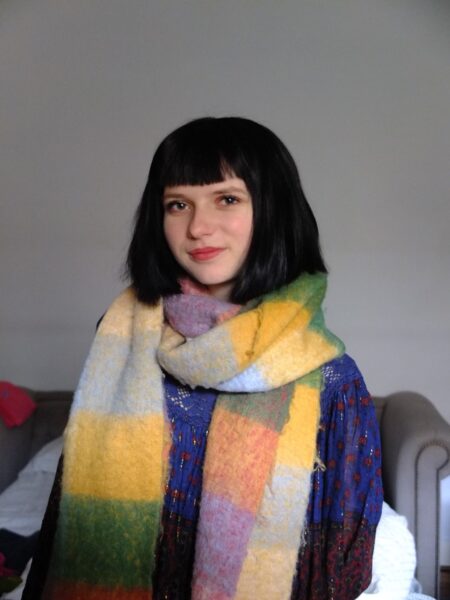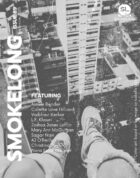“Animal Therapy” is lovely through and through. I want to particularly call out your writing about appetite. There are some great lines about the characters’ disgust toward the brownies in the first paragraph: “… the granules sticking to our butter-slick hands like the wet sand projects she’d forced us to make last week” and Chrstina’s dialogue, “‘What if you tried licking your fingers? Licking the spatula?’” The story’s ending harkens back to its opening, only now the characters are all appetite. Do food and appetite appear in your fiction often?
The verb “appear” feels exactly right. Food and appetite tend to appear in my fiction at their command, the way a reflection appears in the mirror first thing in the morning when the last thing one wants is to see their pillow-smushed face. I think writers have less control over their subject matter than they like to think. We don’t do the picking; we’re picked.
I read a lot of food writing because of how directly it activates the senses, letting us smell, taste, salivate. The way food embodies both the universal and the particular also keeps me coming back. A global language, ubiquitous across all cultures, but also something totally personal. Even within my own family is a scatter of palates (my mom loves all eggs, even scrambled to rubber, I’ll only eat runny yolks, and my dad abhors them—won’t even eat custard or soufflé!). Somewhere in there is a metaphor for reading, how we all process the same text but come away with wildly different responses. So, while I don’t always feel like I’m at the wheel when food and appetite show up in my fiction, I’m a happy, hungry passenger.
What, if anything, did you know about this story before you began writing it?
I had the story worked out in reverse. A last line fully formed in my head that, funnily enough, didn’t even make the final cut. The task was to retrace my steps, connect point B to point A. There were certain elements I knew I wanted to include, like the first-person plural voice, which had a double function. For one, it captured the deindividuation caused by eating disorders, while also enabling the formation of community, something the eating-disorder brain roils against, craving dark corners, secrecy, isolation. So even in the first paragraph, when the we-group is fractured and competitive, organizing hierarchies of thinness, there’s still the suggestion of something shared. That was my through line, how I traversed from ending to beginning.
What surprised you in the writing?
Midway through, a twist occurs that rewires every character’s brain far more speedily than I’d planned. I expected a slower crescendo and even intended to revise the draft to extend that inflection point. I asked my readers whether they felt it was too sudden and absolute a reprogramming. To my surprise, the pace worked for them, but it made more sense the longer I puzzled over it. Eating disorder recovery, of course, is grueling. There’s no quick fix, no advance-to-go-and-collect-$200 card. But in those early, teething stages, many people are just waiting for permission to get better. Seeing someone else commit can be contagious. Even though the acceleration was partly me racing to wrap it up before class, it ended up landing in a way I hadn’t anticipated but liked.
If you could (or had to?—snuck-in bonus question: Which is it for you—could or had to?) transform into another animal, what would it be?
To answer your bonus question: There’s no way I’d ever transform into another animal unless I “had to.” (Amusing to contemplate the circumstances that would oblige this transformation—there’s a story in there.) Fully prepared to make some enemies here, but I’m not what you’d call an “animal person.” If it sheds, slobbers, or does strange things to its own shit, no thank you. And I’m not ashamed: I like my opposable thumbs!
But if a malevolent-benevolent wizard zapped me with a wand, evil enough to force me to turn into an animal, kind enough to offer me the choice of species, I’d (reluctantly) be a seahorse. Underwater creatures I can tolerate, maybe because our encounters are limited. I like their odd geometry: the tubular snout, the bony ridges, the curling tail. Also cool that the dudes get pregnant.
Is there anything in particular you’re willing to share that you’ve learned from or stolen or inherited from your mother (and my good friend), Kim Magowan, about writing flash fiction? Another snuck-in bonus question: What do you think she has learned or stolen from you?
Frankly, who knows if I ever would’ve heard of flash fiction if I had a different mom. She’s the first person who reads my scruffy, five-o’-clock-shadow drafts, my biggest cheerleader, still continuing to pay my Submittable fees! It’s a chicken-and-egg question, if I write because of her, if I read because my parents are both English professors, or if it’s encoded in my DNA. She’s definitely taught me to love and value the miniature. Sometimes insecurity hijacks, and I ask her if I should concentrate my efforts on a novel or some longer, more “impressive” project. She scoffs: Hello, what about Lydia Davis? The most important thing I’ve learned, among many lessons about going for the jugular, writing what I know, choosing words carefully, is that flash is no less potent because it’s small.
I’m a more disciplined writer than my mom, so maybe she’s absorbed a thing or two from me about consistency, writing even when you’re blocked. I want to see our names next to each other on a bookshelf someday.


